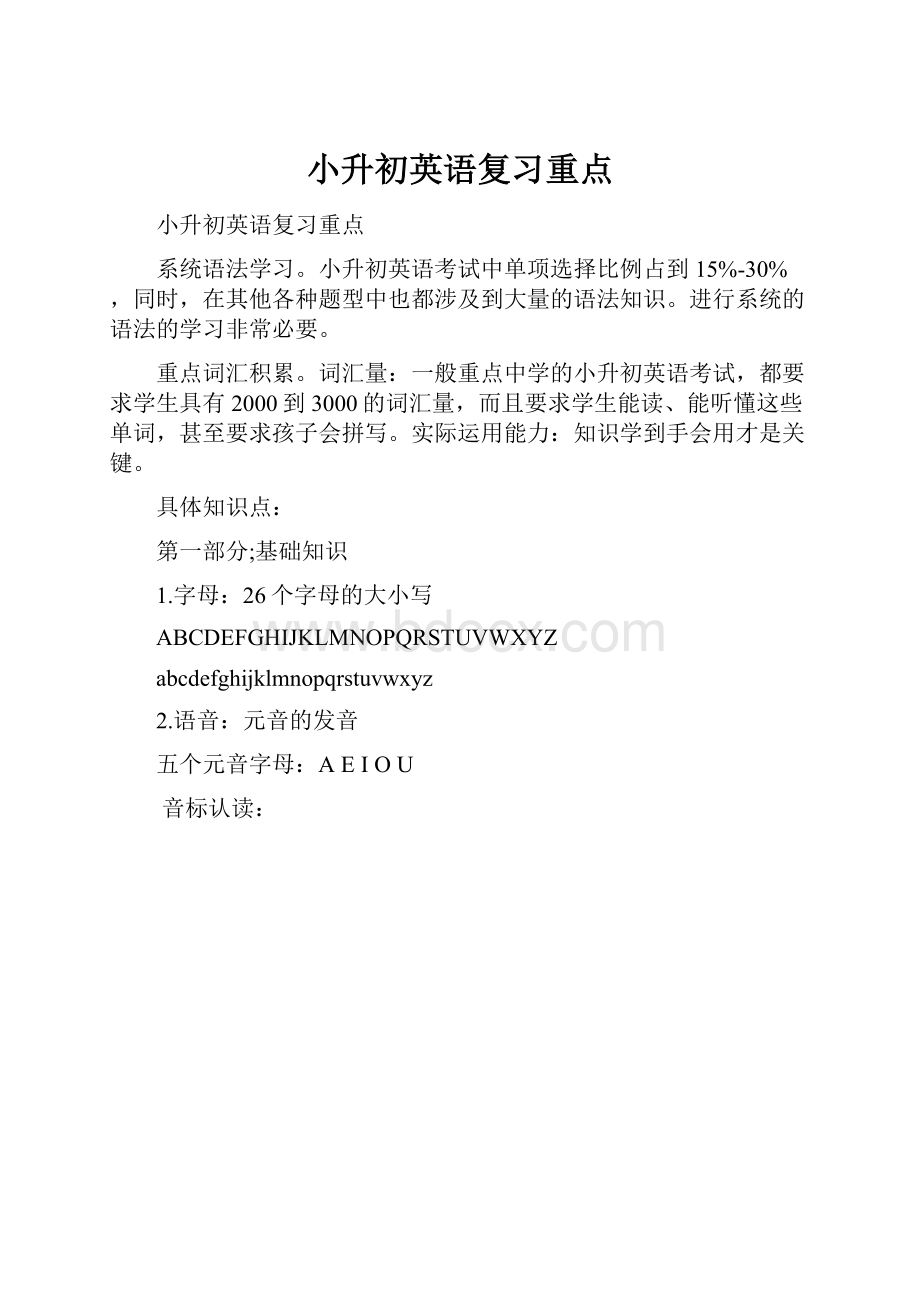小升初英语复习重点.docx
《小升初英语复习重点.docx》由会员分享,可在线阅读,更多相关《小升初英语复习重点.docx(24页珍藏版)》请在冰豆网上搜索。

小升初英语复习重点
小升初英语复习重点
系统语法学习。
小升初英语考试中单项选择比例占到15%-30%,同时,在其他各种题型中也都涉及到大量的语法知识。
进行系统的语法的学习非常必要。
重点词汇积累。
词汇量:
一般重点中学的小升初英语考试,都要求学生具有2000到3000的词汇量,而且要求学生能读、能听懂这些单词,甚至要求孩子会拼写。
实际运用能力:
知识学到手会用才是关键。
具体知识点:
第一部分;基础知识
1.字母:
26个字母的大小写
ABCDEFGHIJKLMNOPQRSTUVWXYZ
abcdefghijklmnopqrstuvwxyz
2.语音:
元音的发音
五个元音字母:
AEIOU
音标认读:
一、元音
前元音:
[i:
][i][e][æ]
[i:
]
发音组合:
eeeeaieei
代表单词:
meheweeven
beefeelbreeze(微风,简单的事)deepfreeSeat(座位)beat(打,击,敲;冲击)
lead(引领,最前端)teaeatreason
Grief(悲痛,伤痛)believeachieve
Receive(收到,接收)conceive(构想,想象)
[i]
发音组合:
i
代表单词:
sitbitkickpickwish
[e]
发音组合:
eeaa
代表单词:
pentenbestbegeggnet
breadheaven(天堂,天国)
marryanymany
[æ]
发音组合:
a
代表单词:
capmapbadmad(发疯的,发狂的)bankthanklamp(灯,油灯,灯火)
中元音:
[ə:
][ə]
[ə:
]
发音组合:
orirerurear
代表单词:
workworkerworm(蠕虫,使缓慢前进birddirt(污物;)affirm(断言,申明)termBurn(烧毁)
surf(碎浪,海浪;浪花)Pearl(珍珠)learn
[ə]
发音组合:
aeror
代表单词:
appearariseagainalikeamanapenteachermotherbrotherdriverangerdoctor
actortutor(家庭教师,私人教师)
famousjealous(妒忌的,吃醋的)
后元音:
[a:
][ʌ][u:
][u][ɔ:
][ɔ]
[a:
]
发音组合:
arearal
代表单词:
fardarkhartfarmgarden
barstarhearthalf
[ʌ]
发音组合:
uo
代表单词:
upcutbutbusluckbutter(奶油)
Monk(和尚)onion(洋葱)
[u:
]
发音组合:
oooouu
代表单词:
foodfool(蠢人)boom((雷,大炮等的)隆隆声)coolhoop(铁圈,戒指,耳环)pool(水塘,水池)
shoot(发射,放射)tombgroupblue
clue(提示,线索)ruletruth
conclude(推断出,结束)
[u]
发音组合:
oouou
代表单词:
footgoodcook(煮,烧)hook(钩,挂钩)tookPull(拉,拖,牵,拽;搬走)
fullbull(公牛,壮汉,)should
[ɔ:
]
发音组合:
aooawouoreauorar
代表单词:
talkballhall(会堂;大厅)calldoorfloorLaw(法律)sawboughtfought(fight的过去式和过去分词,打仗;搏斗;打架;奋斗)
thoughtbeforeignorecaughtnaughty(顽皮的,淘气的;撒野的)nautical(海上的;船员的;船舶的;航海的)forcebornsort(种类,品种,类型)warn
[ɔ]
发音组合:
o
代表单词:
notcop(抓,捕)rot(腐烂,腐坏;腐朽,破损)hotlotdognodshop
合口双元音为:
[ei][ai][ɔɪ][au][əu]
[ei]
发音组合:
eiaaiay
代表单词:
eightdaymaypaidmain
cakefatenakedsnakelakemakename
[ai]
发音组合:
yiuy
代表单词:
crydrymy
kitehighbiketightfinetimebuyguy
[ɔɪ]
发音组合:
oyoi
代表单词:
toyboyloyal
noisevoicepointsoilcoinoil
[au]
发音组合:
ouow
代表单词:
housesoundoutnoun
bowtownnowtower
[əu]
发音组合:
oowoa
代表单词:
hostnosetoneholenotecokecope
bowlknowlowown
boatcoat
集中双元音为:
[iə][ɛə][uə]
[iə]
发音组合:
eerearere
代表单词:
beerdeerhearnearfearhere
[ɛə]
发音组合:
airearareere
代表单词:
hairfairairchairbearswear
dareharethere
[uə]
发音组合:
oorureour
代表单词:
poorluresuretour
二、辅音
爆破音:
[p][b][t][d][k][g]
[p]
发音组合:
p
代表单词:
paypipeputpiepeach
sportspeedspend
[b]
发音组合:
b
代表单词:
birdbedbagbigbuybakebillbearbook
[t]
发音组合:
t
代表单词:
teateacherteamtaretanktaughttip
itmeetcatthoughtfatetentboat
studentstandstick
[d]
发音组合:
d
代表单词:
dodiddoesdeerdatedigdoom
needbedclimbed
[k]
发音组合:
ckck
代表单词:
cakecarcancatcome
kiteskykeeppickback
[g]
发音组合:
g
代表单词:
geesegogapget
bigbagbeg
爆破音小结:
1)[p][t][k]是清辅音,发音时声带不震动,送气要强。
2)[b][d][g]是浊辅音,发音时声带必须震动。
摩擦音:
[f][v][θ][ð][ʃ][3][s][z][h][r]
[f]
发音组合:
fph
代表单词:
fivefirstlifefinefatfailfairfallfarm
telephonephoneticsphoto
[v]
发音组合:
v
代表单词:
votevinevatvailveryvase
leavefive
[θ]
发音组合:
th
代表单词:
thinkteeththickthemethankthought
bothtoothtruthfifthmouthclothfaithbreath
[ð]
发音组合:
th
代表单词:
thisthatthesethosethenthanthough
[ʃ]
发音组合:
shsssch
代表单词:
shipfishsheetsheepdish
sureensureassuremachine
[3]
发音组合:
s
代表单词:
pleasureusualleisuremeasure
[s]
发音组合:
sc
代表单词:
seemsetseeksaysee
booksdensemousecupsfaceiceraceprice
[z]
发音组合:
zs
代表单词:
zooprizezeal
raisekneeseyes
[h]
发音组合:
hwh【注意】wh在元音字母o前才发此音。
代表单词:
hothomehousehorsehatehigh
wholewhowhosewhom
[r]
发音组合:
rwr
代表单词:
raceredricerainrightroad
freefrypraywrongwrite
摩擦音小结:
英语中有十个摩擦音即:
[f][v][θ][ð][ʃ][3][s][z][h][r]
发摩擦音时必须注意:
1)口腔通道不完全阻塞,留有窄小空隙,气流从中泄出时摩擦或震动成音。
2)摩擦音可以延长而发音器官位置不变。
破擦音:
[tʃ]
发音组合:
ch
代表单词:
cheapchildchestchokecheck
catchwatch
[d3]
发音组合:
jgdg
代表单词:
jeepjokejewjuicejudge
[tr]
发音组合:
tr
代表单词:
treetreattriptraintram
[dr]
发音组合:
dr
代表单词:
dreamdragdrawdrinkchildren
[ts]
发音组合:
ts
代表单词:
sitsseatsmatespeasantsparents
[dz]
发音组合:
ds
代表单词:
needsseedsspends
鼻辅音:
[m][n][ŋ]
[m]
发音组合:
m
代表单词:
somecomedime
mothermapmoon
[n]
发音组合:
n
代表单词:
noonnosenotenotnonothing
moonsoonsongunthinrundinegain
[ŋ]
发音组合:
ngn
代表单词:
singsongsingerkingthing
inksinkthanktank
舌边音:
[l]
发音组合:
l
代表单词:
清晰音[l]letladlatelaidleaplap
代表单词:
含糊音[l]dealtellbeltsaletable
半元音:
[w][j]
[w]
3.词汇:
词汇量,近反义词
4.句子:
大小写,标点符号
第二部分:
语法知识
一名词:
名词单复数,名词的格
名词分为可数名词和不可数名词
可数名词有:
appledeskpenpencilbox
不可数名词有:
paper,juice,water,milk,rice,tea
(一)名词单数变复数
1.一般情况,直接加-s,如:
book-books,bag-bags,cat-cats,bed-beds
2.以s.x.sh.ch结尾,加-es,如:
bus-buses,box-boxes,brush-brushes,watch-watches
3.以“辅音字母+y”结尾,变y为i,再加-es,如:
family-families,strawberry-strawberries
4.以“f或fe”结尾,变f或fe为v,再加-es,如:
knife-knivesleaf--leaveswife--wives
5、以字母o结尾的加es的有:
heroNegrotomatopotato
其他以o结尾的都加s如zoophoto
6.不规则名词复数:
man-men,woman-women,policeman-policemen,policewoman-policewomen,mouse-micechild-children,foot-feet,tooth-teeth,
7、单复同形:
fish-fish,people-people,sheep-sheep
8、中日不变英法变,其他s加后面Chinese-Chinese,Japanese-Japanese
Frenchman--FrenchmenEnglishman---EnglishmenGerman---Germans
(二)名词的格
(1)有生命的东西的名词所有格:
a)单数后加’s如:
Lucy’srulermyfather’sshirt
b)以s结尾的复数名词后加’如:
hisfriends’bagsTeachers’Day
c)不以s结尾的复数后加’schildren’sshoes
●并列名词中,如果把’s加在最后一个名词后,表示共有,如:
TomandMike’scar汤姆和迈克共有的小汽车
●要表示所有物不是共有的,应分别在并列名词后加’s
Tom’sandMike’scars汤姆和麦克各自的小汽车
(2)表示无生命东西的名词通常用“of+名词”来表示所有关系:
如:
apictureoftheclassroomamapofChina
二.冠词:
不定冠词,定冠词种类:
(1)不定冠词:
a/anaunit/anuncle
元音音素开头的可数名词前用an:
anegg/anapple/anorange/aneraser/ananswer/anIDcard/analarmclock/anactor/anactress/ane-mail/anaddress/anevent/anexample/anopera/anhouranoldman/aninterestingbook/anexcitingsport/anactionmovie/anartlesson/
(2)定冠词:
thetheeggtheplane
2.用法:
定冠词的用法:
(1)特指某(些)人或某(些)物:
Therulerisonthedesk.
(2)复述上文提到的人或物:
Hehasasweater.Thesweaterisnew.
(3)谈话双方都知道的人或物:
Theboysaren’tatschool.
(4)在序数词前:
John’sbirthdayisFebruarythesecond.
(5)用于固定词组中:
inthemorning/afternoon/evening
不用冠词的情况:
(1)专有名词前:
Chinaisabigcountry.
(2)名词前有定语:
this,that,my,your,some,any,no等:
Thisismybaseball.
(3)复数名词表示一类人和事:
Monkeyscan’tswim.Theyareteachers.
(4)在节日,日期,月份,季节前:
TodayisChristmasDay.It’sSunday.
(5)一日三餐前:
Wehavebreakfastat6:
30.
(6)球类棋类运动前:
Theyoftenplayfootballafterclass.Heplayschessathome.
*但乐器前要用定冠词:
Iplaytheguitarverywell.
(7)学科名称前:
Myfavoritesubjectismusic.
(8)在称呼或头衔的名词前:
ThisisMrLi.
(9)固定词组中:
atnoonatnightbybus
三、代词:
人称代词,物主代词
形容词性物主代词+名词=名词性物主代词mybook=mine
四、形容词,副词:
比较级,最高级
(一)、形容词的比较级
1、形容词比较级在句子中的运用:
两个事物或人的比较用比较级,比较级后面一般带有单词than。
比较级前面可以用more,alittle来修饰表示程度。
than后的人称代词用主格(口语中可用宾格)。
2.形容词加er的规则:
⑴一般在词尾加er;
⑵以字母e结尾,加r;
⑶以一个元音字母和一个辅音字母结尾,应双写末尾的辅音字母,再加er;
⑷以“辅音字母+y”结尾,先把y变i,再加er。
3.不规则形容词比较级:
good-better,beautiful-morebeautiful
(二)副词的比较级
1.形容词与副词的区别(有be用形,有形用be;有动用副,有副用动)
⑴在句子中形容词一般处于名词之前或be动词之后
⑵副词在句子中最常见的是处于实义动词之后
2.副词比较级的变化规则基本与形容词比较级相同(不规则变化:
well-better,far-farther)
3、频率副词,alwaysusuallyoftensometimesnever
例如:
IalwaysgoshoppingonSunday.
对频率进行提问用howoften
Howoftendoyouplaytennis?
Onceaweek.
Once一次twice两次threetimes三次fourtimes四次依次类推
五、数词:
基数词,序数词一、基数词
基数词:
(1)1-20
one,two,three,four,five,six,seven,eight,nine,ten,eleven,twelve,thirteen,fourteen,fifteen,sixteen,seventeen,eighteen,nineteen,twenty
(2)21-99先说“几十”,再说“几”,中间加连字符。
23→twenty-three,34→thirty-four,45→forty—five,56→fifty-six,67→sixty-seven,78→seventy-eight,89→eighty-nine,91→ninety-one
(3)101—999先说“几百”,再加and,再加末两位数或末位数;
586→fivehundredandeighty-six,803→eighthundredandthree
(4)l,000以上,先从右往左数,每三位数加一个“,”,第一个“,”前为thousand.第二个“,”前为million,第三个“,”前为billion
1,001→onethousandandone
18,423→eighteenthousand,fourhundredandtwenty-three
6,260,309→sixmilliontwohundredandsixtythousandthreehundredandnine
750,000,000,000→sevenhundredandfiftybillion
序数词:
(1)一般在基数词后加th
eg.four→fourth,thirteen→thirteenth
(2)不规则变化
one→first,two→second,three→third,five→fifth,eight→eighth,nine→ninth,twelve—twelfth
(3)以y结尾的十位整数,变y为ie再加th
twenty→twentieth,forty→fortieth,ninety→ninetieth
(4)从二十一后的“几十几”直至“几百几十几”或“几千几百几十几”只将个位的基数词变为序数词。
twenty-first,twohundredandforty-fifth
基数词转为序数词的口诀:
基变序,有规律,词尾加上-th.
一,二,三,特殊记,词尾字母t,d,d.
八去t,九去e,ve要用f替。
ty将y变成i,th前面有个e.
若是碰到几十几,前用基来后用序。
六、介词:
常用介词:
in,on,at,behind等
On在-----上面under在-----下面infrontof在----前面nextto在----旁边
in在---里面behind在----后面between在---之间
1.at表示时间概念的某一个点。
(在某时刻、时间、阶段等)。
at1:
00(dawn,midnight,noon)在一点钟(黎明、午夜、中午)
atChristmas在圣诞节
2.on1)星期前onSunday表示具体的某一天前ontheApril10th
例如:
关于"在周末"的几种表示法:
Ontheweekend在周末---特指
duringtheweekend在周末期间
2)在---上面onthetable
3.in在---里面、月份前、季节前
例如:
inthebox在盒子里inMay在五月份inSpring在春天
例如:
Whereisthebook?
It’son\underthesofa.
Whereistheball?
It’sinthebox.
七、情态动词:
表示
Can能、会should应该must必须haveto不得不,may可能,情态动词无人称和数的变化;不能单独使用,必须与其后的动词原形构成谓语。
例如:
Icanswim.Ihavetogotoshool.Idon’havetogotoshoolonSunday.
八、be动词
Be动词的用法:
(1)Am--wasIs--wasAre--were口诀:
我用am,你用are,is用在他她它,复数全用are。
(2)肯定和否定句Iam(not)fromLondon.Heis(not)ateacher.Sheis(not)inthediningroom.Myhairis(not)long.Her